As a kid, I didn’t understand why anyone could cite King Kong as their favorite monster. If monsters were like a box of toys, Kong would be the one I would always pick last. (Like how my sister constantly neglected imitation Barbie dolls that weren’t manufactured by Mattel.) Because I was born in 1981, I could watch every classic monster movie ever over the course of a summer on VHS. Compared to his peers, Kong wasn’t outrageous enough to be cool. A famous monster needed powers, fangs, scales, fire breath, transformation powers, or at the very least should have looked like something you’d never see in a zoo. Because apes are real, I wasn’t convinced a giant one might not exist somewhere in the world. Plus, there were just too many human characters in the movie, and the money shots I craved of an over-sized monster tearing up a city didn’t come until the very end.
However, I was wrong! King Kong works because its premise is (mostly) convincing and perhaps even plausible. This film was a talkie made for grown-ups who may or may not have been ready for the meta-fictional meditations of a giant ape who loved a woman and the film director who needed them both.
Unless you’re an impatient squirmy-pants who needs explosions on the screen every 30 seconds to keep your attention, then you’ll probably agree that the pacing of King Kong is pretty damn good. (Considering the movie was made in 1933.) From the first shot the mood is established: a theatre agent walks along the foggy New York docks and controversy surrounds the impending departure of a certain ship. Is the trip doomed? Has egomaniac movie director Carl Denham gone too far this time? Where is the ship headed, anyway? Right away, a plot-driven movie is being presented to the audience, which is actually a little misleading, because King Kong’s story is actually a little more complex than that.
Here’s the set-up of King Kong in brief: film director Carl Denham embarks on a mysterious journey to an island not plotted on any western maps. With him he takes Ann Darrow, a beautiful down-on-her-luck girl who he finds on the streets of Manhattan attempting to steal some fruit. With Ann and a motley crew of for-hire sailors including “The Skipper” and the square-jawed handsome, (supposedly) dashing first-mate Jack, Denham sets out for the mysterious island where the film director is sure he’ll find some totally crazy shit that will serve as the subject of his next film.
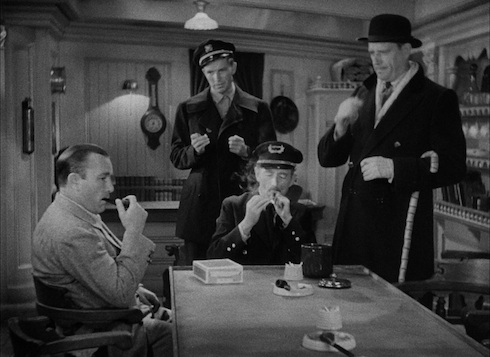
Some of the writing is little rocky at first, and the clunky, outdated warts of the film are visible mostly in these early scenes. Denham wants the ship to leave the dock ASAP, either because they’re carrying a bunch of illegal explosives or because of an impending monsoon storm. But which is it? The plot device keeps changing. Denham also keeps the location of the island a secret from The Skipper and Jack until they’re practically five minutes away from it. Why? He’s already loaded a bunch of gas bombs and guns onto the ship, why not let them in on the rest of the plan?
When he does reveal that they’re headed to an island no one has ever heard of, everyone stands around and says that they’ve never heard of it. But then, the Skipper randomly has heard of the “native” legend of Kong. Which natives are these? Natives of what exactly? The sort of racist caricatures that pervaded Johnny Quest cartoons are on full display in King Kong. It’s pretty sexist, too, with Jack actually accidentally slapping Ann in an early scene, and apologizing several minutes later. Then, you’ve got Charlie, the “oriental” cook who is clearly not played by an Asian man, and is doing a terrible Charlie Chan sort of faux-accent while peeling potatoes. Luckily, the movie isn’t about any of these things, and if you’ve got your wits about you, you’ll recognize these are just unattractive byproducts of the era in which the film was made. Also, the movie is doing so much work to remind you what you’re watching is a MOVIE that the meta-fictional aspects almost excuse some of the cultural insensitivity.
Seen from what I think is the correct vantage point, King Kong isn’t the story of a monster abducting a woman and traipsing through Manhattan, but instead a story about how artistic expression can bleed out into the real world. Carl Denham is dead-set on making a movie about whatever monster or monsters lurk beyond Skull Mountain. Because he’s a hacky filmmaker (and rightfully portrayed as one) he’s slapping on a simple “Beauty and the Beast” metaphor to the movie he’s trying to make. He’s so sure of this simple premise that he even has Ann practice screaming at the sight of “the beast” before they reach the island.
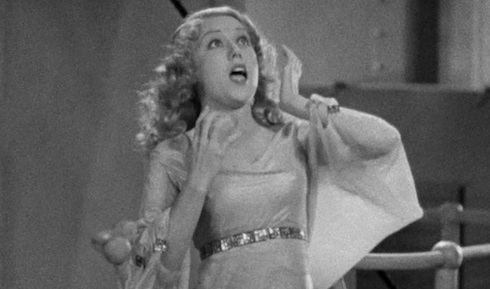
This is perhaps the most perfect moment in the entire movie because the scream Fay Wray’s Ann emits on the deck of the ship is identical to the scream she ends up emitting over and over again once Kong shows up for real. This doesn’t make the structure of the movie determinist or sloppy, but instead highly theatrical and smart. From above the deck, the Skipper and Jack talk. Jack (a total bro and a moron) says in reference to Denham “Think he’s crazy?” to which the Skipper replies “No, just enthusiastic.” It’s at this point the audience should realize that none of the characters are all that bright. They’re all average, dull, maybe even dim-witted people who are on a collision course with total disaster. And I believe this is the movie’s intention. Smart people wouldn’t have gone out in search of Kong to make a hacky movie. Instead, this enterprise is being lead by a lunatic and supported by people who are ignorant, desperate, or on his payroll.
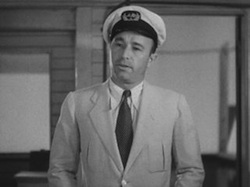 Imagine a reality show about a bunch of idiots going to try and make a movie about capturing a giant ape. They’re asked to come up with some kind of premise as to what they’re movie would be about. Even without King Kong sitting in the collective unconscious, our potential group of idiots would likely come up with Carl Denham’s hacky “Beauty and the Beast” premise. The reason why the movie is thematically awesome is because it’s realistic. Did Denham actually want to abandon the film project and bring Kong back to New York as a live act? Probably not initially because such a thing, for a rational mind, would have been too costly and dangerous. But post-island danger, Denham and Ann and Jack all start to believe in their own mythology. (To be fair, Ann is probably the smartest person among all the characters, insofar as she’s not in denial of her fear. Any reasonable person would be screaming for the entire movie, too.) In any case, the belief in this self-mythology is what leads to terror descending upon New York. Denham’s final line “it was beauty who killed the beast” is ironic because Carl Denham killed Kong by bringing him to New York AND by being an egomaniac who allowed his insane concept of blending art with real life to put a lot of people in danger. This to me is why the movie is brilliant. The monster is Denham.
Imagine a reality show about a bunch of idiots going to try and make a movie about capturing a giant ape. They’re asked to come up with some kind of premise as to what they’re movie would be about. Even without King Kong sitting in the collective unconscious, our potential group of idiots would likely come up with Carl Denham’s hacky “Beauty and the Beast” premise. The reason why the movie is thematically awesome is because it’s realistic. Did Denham actually want to abandon the film project and bring Kong back to New York as a live act? Probably not initially because such a thing, for a rational mind, would have been too costly and dangerous. But post-island danger, Denham and Ann and Jack all start to believe in their own mythology. (To be fair, Ann is probably the smartest person among all the characters, insofar as she’s not in denial of her fear. Any reasonable person would be screaming for the entire movie, too.) In any case, the belief in this self-mythology is what leads to terror descending upon New York. Denham’s final line “it was beauty who killed the beast” is ironic because Carl Denham killed Kong by bringing him to New York AND by being an egomaniac who allowed his insane concept of blending art with real life to put a lot of people in danger. This to me is why the movie is brilliant. The monster is Denham.
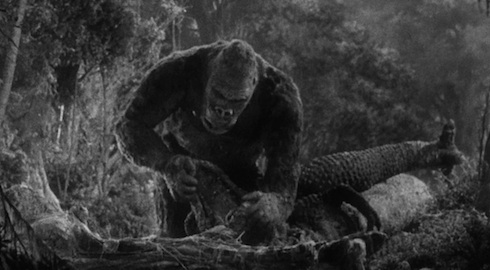
But this is a monster movie, with a proper monster, so what about the visuals? Once we start to see the interior of the island, the gorgeous stop-motion monster stuff will delight anyone how has an appreciation for the craftsmanship of this wonderful lost art. As a child I remember loving the scene where Kong fights the T-Rex and I’m happy to report it is still gripping and looks perfect. The thing I think people tend to forget about this scene is how brutal King Kong is when he finally kills the T-Rex. Kong pulls open the jaws of his enemy until he literally BREAKS HIS FACE. The cracking sounds are chilling. King Kong is a killer, far worse than anything the characters could have conceived of. Willis O’Brien was of course the stop-motion maestro responsible for King Kong and his apprentice was none other than Ray Harryhausen. Though Harryhausen didn’t work on King Kong, he would later meet Willis O’Brien and even collaborate with him on the original version of Mighty Joe Young in 1949. It could be argued that the world would not have been given Harryhausen’s brand of stop-motion if it were not for Willis O’Brien’s work on King Kong. Indeed, the visual effects of Kong also inspired Eiichi Tsuburaya, the man responsible for Gojira (Godzilla) who, if Tsuburaya had had his way, would have also been rendered as stop-motion monster.
The influences King Kong has precipitated on movies and the cultural are probably too numerous to actually catalogue but I think it’s easy to assert that none of the sequels or various remakes are remotely as brilliant as the original. (For one thing the Peter Jackson version is just too long.) But in this 1933 film, all of the meta-fictional jibes and dramatically ironic punches land perfectly. For a movie about a giant ape, it’s all fairly elegant.
Ryan Britt is the staff writer for Tor.com.










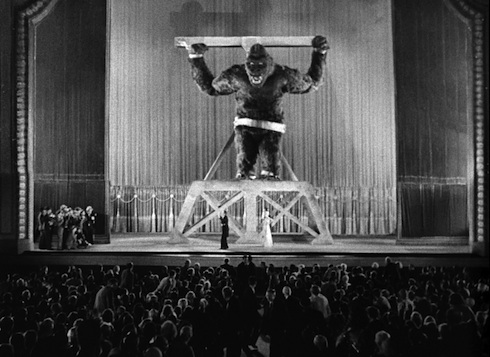
It is the classic monster movie The amazing thing is how well the fx stand up after all these years.
I think you have to realize that it was a period piece and the racism is good to see from a historical standpoint. Thats particularly true because it is more taken for granted, not even a subject of discussion. Give a good view of the time. For the same reason, we should still read books like Tom Sawyer. History is a great teacher.
Count me among those viewers who appreciated the original King Kong much more upon a second viewing. It does help to try and imagine how adult viewers would have experienced the film in 1933, or how kids of the pre-Star Wars years would have viewed it on TV.
The films’ directors Merian C. Cooper and Ernest B. Schoedsack had made their reputations with films shot in exotic locations–the documentary Grass: A Nation’s Battle for Life, the semi-documentary Chang: A Drama of the Wilderness (nominated for an Oscar for “artistic quality of production”) and a silent version of The Four Feathers featuring none other than Fay Wray. Given their backgrounds, and the fact that the bulky sound movie cameras of the 1930’s made their freewheeling use of location shooting impossible, it’s not surprising that they came up with a fanciful scenario about an “enthusiastic” documentary filmmaker.
@1 john
I hear you. I think that’s why I said I feel like the meta-fictional aspects of the movie more than make-up for its dated shortcomings.
From all reports, people screamed and fainted when the film was first released. There had been a scene of men being devoured by giant spiders and scorpions, but they had to cut it, as it was so graphic people actually ran out of the theater! Even the ones who stayed, apparently, were so wigged out by the scene that they stopped paying attention to the movie and just talked about it. Freaky! I had never realized there was such a strong reaction. Of course it’s different seeing it on a little bitty screen, introduced by someone like Sir Graves Ghastly or the Cryptkeeper, than it must have been seeing it for the first time in a theater – especially when nothing like it had been done before. I’d love to have been a part of that audience.
I’ve got an essay about KK archived somewhere, titled “A Perfect Pulp Storm” or something like that; an attempt to get into David Brin’s essay collection.
There’s no one thing absolutely great about King Kong (well, the special effects were astounding for the time), all the stuff together — music, SFX, a non-stop script — makes it a pulp film for the ages. An absolutely terrific ripping yarn.
* * *
For me and millions of other NYC-area residents of a certain age, memories of King Kong are strongly tied with the smell of baking turkey and a horde of visiting cousins. One of the NYC indie stations — either WPIX or WOR — ran King Kong (followed up by Laurel & Hardy’s Babes in Toyland) on Thanksgiving for decades.
* * *
In addition to his own, over-long King Kong remake, Peter Jackson also did a very thorough and respectful restoration of the original film. The DVD includes some wonderful documentaries, snippets from Cooper’s earlier films, and Jackson’s attempt at recreating a “lost scene” in which the sailors who survived the fall into the gulch are attacked and killed by giant critters. They dressed up the segment’s actors in copies of the old costumes, and used stop motion to create the critters.
I still feel that there’s a better movie buried in Jackson’s remake.
The scenes that work really work (T-Rex, first meeting of Ann and Kong) but the padding leaves you feeling bleargh at the end. Even just cutting 2/3 of the tower footage would have helped. After all, it’s not like there is any suspense on whether Kong is going to survive or not…
Unfortunately Jackson just loved King Kong too much to make the cuts that were needed (and after LoTR people thought he walked on water).
As a kid, I didn’t like King Kong. Maybe it was the chopped-up version they showed on TV then, or maybe the difficulty of caring about a gigantic ape, I don’t know for sure. But as I grew older and realized the movie was Carl Denham’s story, not Kong’s or Ann Darrow’s, it became one of my favorite classic monster movies. Ryan nails the movie (just as actor Robert Armstrong nails his portrait of Carl Denham). Ryan’s critique is the best review of King Kong I’ve read.
@7 Thanks Drunes!
Hey Ryan,
You might like this King Kong story:
sobuttons.com/kong.htm
Jonathan
Jack was smart enough to see that Denham was crazy. Also the Empire State Building had just been built, so KK climbing to the top gave it a new purpose, pick your own symbology here.
I have to agree with Ryan Britt when talks about the King Kong and T-Rex fight. Kong is not only breaking the jaws of the T-Rex, he is also breaking its neck while shoving in the skull into its brain! Combined with the cracking noises and the blood, this scene is quite brutal! Not to mention how Kong seems to be going out of his way to humiliate the T-Rex when he rides the dinosaur like a horse. Oddly enough, as a kid, I found myself becoming aroused by this, especially at the climax when you hear Kong literally breaking all the bones in the jaws and face of the T-Rex. It’s such utter domination, that its hard not to get turned on by it in some fashion.
james977 – amazing. I was the same way as a kid. I’d wank myself silly every time i’d see that part as a pre teen in the early 60’s! must admit I still go on occasion
T-rex lover – It’s good to know that I’m not the only one who experienced these “funny” feelings watching this as a kid. I’m younger than you are, (thirties), I have a good job, and have no problem talking to or attracting the ladies, yet despite this, I never really got over becoming turned on watching this scene. (I guess its hard to shake off certain things you pick up as a kid when you’re an adult.) In addition to the fight itself, I think its also the combination of how the scene is in black and white as well as the use of stop motion that gives it such a surreal feeling, which (in a way) adds to the overall excitment. Composer Max Steiner wisely lets the soundtrack go silent when it comes time for the fight, because it allows us to hear every bone break apart when Kong crushes in the jaw and face of his adversary. Believe it or not, I still consider the T-Rex one my favorite dinosaurs, (and I assume you do to going by your name). But at the same time, its hard to deny getting excited watching it get owned by Kong!
I really hate that Kong for what he did to the T Rex because of my hatred for mammals, love for reptiles, hatred for humans, and love for animals! In fact, I wish that T Rex bit both of that ape’s hands and arms off before going for the rest of his body.
If anyone asks me, that movie traumatized me in my childhood. What also traumatized me is that a male bully told me that he blew a T Rex’s head off when he and I were in Grade 6. that makes me hate bullies big time.
What I also hate is that some jerk on YouTube posted that T Rex, which is my favorite dinosaur, got what he deserved. What a liar he is! I’d feed him or her to a Tyrannosaurus as well as Kong and that sixth grade bully.
In KING KONG (1933) ‘Charlie the Cook’ was played by an actor named Victor Wong.
https://en.wikipedia.org/wiki/Victor_Wong_(actor_born_1906)